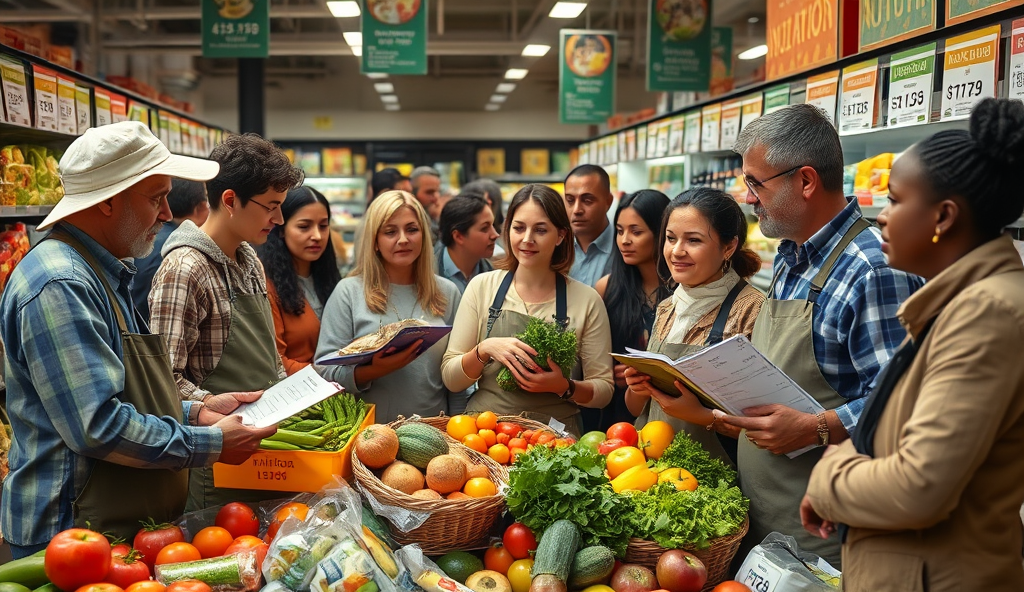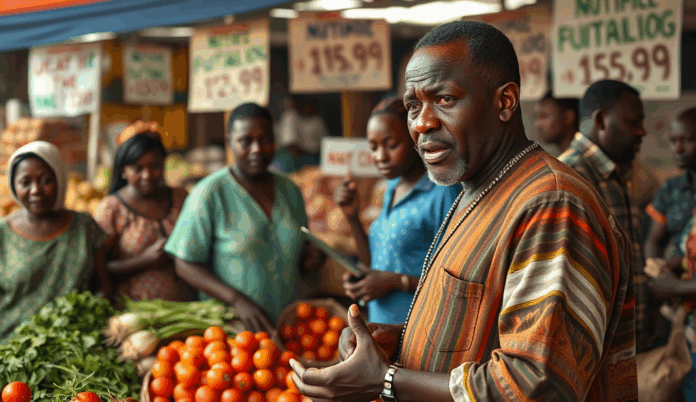Introduction to Nutrition Inflation in Nigeria
Nutrition inflation in Nigeria has reached alarming levels, with food prices surging by over 30% in the past year alone, according to the National Bureau of Statistics. This sharp rise has made basic staples like rice, beans, and vegetables increasingly unaffordable for average Nigerian families, forcing many to compromise on dietary quality.
The impact of inflation on Nigerian diets is evident as households now spend nearly 60% of their income on food, up from 40% just two years ago. Local markets in Lagos and Kano report dwindling purchases of protein-rich foods like fish and eggs, replaced by cheaper but less nutritious alternatives such as garri and noodles.
As rising food prices in Nigeria persist, families face tough choices between quantity and nutritional value, setting the stage for deeper health consequences. This troubling trend directly affects child nutrition and household food security, which we’ll explore further in the next section.
Key Statistics

Understanding the Impact of Rising Food Costs on Nigerian Families
Nutrition inflation in Nigeria has reached alarming levels with food prices surging by over 30% in the past year alone according to the National Bureau of Statistics.
The food affordability crisis in Nigeria has forced families to adopt coping strategies that compromise nutrition, with many substituting protein-rich meals with cheaper carbohydrates like garri and instant noodles. A recent survey by NOIPolls revealed 72% of households now consume fewer fresh fruits and vegetables due to rising food prices in Nigeria, worsening micronutrient deficiencies.
Inflation-driven hunger in Nigeria disproportionately affects children, with UNICEF reporting a 15% increase in stunting rates among under-fives in high-inflation states like Kano and Katsina. Parents often prioritize filling meals over balanced diets, leading to long-term health consequences that compound economic struggles.
These dietary shifts highlight the urgent need for sustainable nutrition solutions for Nigeria, which we’ll explore alongside key nutrients essential for maintaining health despite inflation pressures. The connection between malnutrition and economic inflation in Nigeria underscores why targeted interventions are critical.
Key Nutrients Essential for a Balanced Diet
The food affordability crisis in Nigeria has forced families to adopt coping strategies that compromise nutrition with many substituting protein-rich meals with cheaper carbohydrates like garri and instant noodles.
Despite rising food prices in Nigeria, prioritizing key nutrients can help families mitigate the impact of inflation on Nigerian diets. Protein, iron, and vitamin A are critical for child development, with deficiencies linked to the 15% stunting increase reported by UNICEF in high-inflation states like Kano.
Affordable sources like beans, egusi seeds, and leafy greens can bridge these gaps without straining budgets.
Micronutrients like zinc and folate remain vital for immune function and maternal health, yet 72% of households skip fresh produce due to food affordability crisis in Nigeria. Local staples like unripe plantains (rich in potassium) and crayfish (packed with calcium) offer cost-effective alternatives to imported supplements.
These small dietary adjustments can combat malnutrition and economic inflation in Nigeria.
Sustainable nutrition solutions for Nigeria must emphasize nutrient density over meal volume, especially for children facing inflation-driven hunger. The next section explores how families can leverage affordable local food alternatives to maintain nutrition without compromising health or finances.
Affordable Local Food Alternatives to Maintain Nutrition
Nigerian families can optimize nutrition despite rising food prices by substituting expensive imports with nutrient-dense local staples like ofada rice which provides more fiber and minerals than polished imported rice at 40% lower cost.
Nigerian families can optimize nutrition despite rising food prices by substituting expensive imports with nutrient-dense local staples like ofada rice, which provides more fiber and minerals than polished imported rice at 40% lower cost. Research shows traditional soups using bitter leaf and ugu deliver comparable vitamin A levels to imported spinach while costing 60% less in Lagos markets, directly addressing the food affordability crisis in Nigeria.
Protein needs can be met through strategic combinations like moi-moi (steamed bean pudding) with dried fish, offering complete amino acids at half the price of imported chicken. Northern states demonstrate this effectively, where millet-based kunu paired with groundnut paste provides balanced nutrition for children at just ₦200 per meal, countering inflation-driven hunger in Nigeria.
These practical swaps create sustainable nutrition solutions for Nigeria while preserving cultural food preferences. The next section reveals smart shopping strategies to further maximize these cost-saving alternatives without compromising dietary quality.
Smart Shopping Tips to Stretch Your Food Budget
Timing purchases during seasonal harvests can slash costs by 30-50% for staples like ofada rice and ugu as Lagos market data shows prices drop when local supply peaks.
Timing purchases during seasonal harvests can slash costs by 30-50% for staples like ofada rice and ugu, as Lagos market data shows prices drop when local supply peaks. Bulk-buying cooperatives in Kano demonstrate how families save ₦15,000 monthly by pooling resources for millet and groundnut purchases, directly countering inflation-driven hunger in Nigeria.
Prioritize evening markets where perishables like bitter leaf sell at 40% discounts before closing, while dried fish vendors in Port Harcourt offer better deals on Fridays when fresh catches arrive. These strategic approaches align with earlier nutrition swaps, ensuring affordability without compromising dietary quality.
Adopting these smart shopping habits creates a natural transition into meal planning strategies that further optimize your food budget while maintaining balanced nutrition.
Meal Planning Strategies for Cost-Effective Nutrition
Despite rising food prices in Nigeria families can maintain balanced diets by prioritizing nutrient-dense local staples like beans millet and leafy greens which offer affordability without compromising nutrition.
Building on smart shopping tactics like bulk purchases and seasonal buying, structured meal planning can stretch your food budget further while ensuring balanced nutrition. A study in Enugu showed families reduced weekly food expenses by 22% by designing menus around affordable local staples like beans, plantains, and egusi, aligning with earlier nutrition swaps for protein diversity.
Rotate dishes using overlapping ingredients—like incorporating ugu from discounted evening markets into soups, stews, and salads across the week—to minimize waste and maximize savings. Lagos households report saving ₦8,000 monthly by prepping large batches of jollof rice with seasonal tomatoes and freezing portions, a strategy that dovetails into food preservation methods.
Plan protein-rich meals around cheaper cuts like chicken wings or stockfish rehydrated overnight, complementing them with seasonal vegetables for cost-effective nutrition. These intentional approaches not only combat inflation-driven hunger but also set the stage for preserving surplus food, our next focus for minimizing waste.
Preserving Food to Reduce Waste and Save Money
Extending meal planning strategies, proper food preservation can cut household expenses by up to 30% according to NAFDAC reports, especially when dealing with seasonal gluts of tomatoes, peppers, or leafy vegetables. Sun-drying tomatoes during peak harvest or fermenting leftover garri extends shelf life while retaining nutrients, addressing both food affordability crisis in Nigeria and malnutrition risks.
Traditional techniques like smoking fish or making ogiri from melon seeds prove particularly effective in southern states, where humidity accelerates spoilage. Families in Rivers State preserve over 60% of their bulk-purchased seafood through these methods, creating protein reserves that withstand rising food prices in Nigeria.
Modern approaches like vacuum-sealing cooked beans or blanching frozen ugu retain texture and vitamins better than repeated reheating. These preservation methods not only combat inflation-driven hunger in Nigeria but also create a buffer for lean periods, bridging individual efforts with needed community and government support systems we’ll explore next.
Community and Government Support for Affordable Nutrition
Building on individual food preservation efforts, Nigeria’s National Social Investment Program (NSIP) provides conditional cash transfers to 1 million households monthly, directly combating inflation-driven hunger in Nigeria through targeted nutrition support. Local initiatives like Lagos State’s “Eko Urban Farming” train residents in vertical gardening, complementing traditional preservation methods discussed earlier while addressing urban food affordability crises.
The federal government’s partnership with the World Food Programme has established 2,500 community nutrition hubs across northern states, where rising food prices in Nigeria hit hardest, providing fortified meals to vulnerable children and pregnant women. These hubs incorporate locally preserved foods like smoked fish and sun-dried vegetables, creating sustainable nutrition solutions for Nigeria that align with household-level strategies.
State agricultural extension services now teach modern preservation techniques alongside crop cultivation, with Kebbi’s “Farin Ruwa” project reducing post-harvest losses by 40% through community solar dryers. Such systemic support bridges the gap between personal coping mechanisms and large-scale interventions, setting the stage for sustainable dietary resilience despite economic pressures.
Conclusion: Staying Healthy Despite Nutrition Inflation
Despite rising food prices in Nigeria, families can maintain balanced diets by prioritizing nutrient-dense local staples like beans, millet, and leafy greens, which offer affordability without compromising nutrition. Strategic meal planning and bulk purchases from local markets, as discussed earlier, further stretch limited budgets while ensuring dietary diversity.
The impact of inflation on Nigerian diets demands creative solutions, such as community farming initiatives in Lagos and Kano, which reduce reliance on expensive imports. Government policies on food inflation must align with grassroots efforts to stabilize prices and improve food security for vulnerable households.
Sustainable nutrition solutions for Nigeria require both individual adaptability and systemic change, blending traditional knowledge with modern cost-saving strategies. As we move forward, collective action and informed choices will remain key to overcoming the food affordability crisis while safeguarding health.
Frequently Asked Questions
How can we get enough protein for our children without spending too much on expensive meats?
Combine affordable local proteins like beans and dried fish in dishes like moi-moi to provide complete amino acids at half the cost of chicken.
What are the cheapest ways to preserve vegetables when prices spike during off-seasons?
Sun-dry tomatoes or blanch and freeze ugu leaves during peak harvest to extend shelf life while retaining nutrients.
Can we still get vitamins from local foods when we can't afford imported fruits?
Use bitter leaf and unripe plantains which provide comparable vitamin A and potassium at 60% lower cost than imported spinach and bananas.
How can families with tight budgets plan meals that meet nutritional needs?
Rotate dishes using overlapping local ingredients like beans and egusi across the week to minimize waste and maximize savings.
Where can we find government support for affordable nutrition in high-inflation areas?
Access community nutrition hubs under the National Social Investment Program which provide fortified meals using locally preserved foods.


